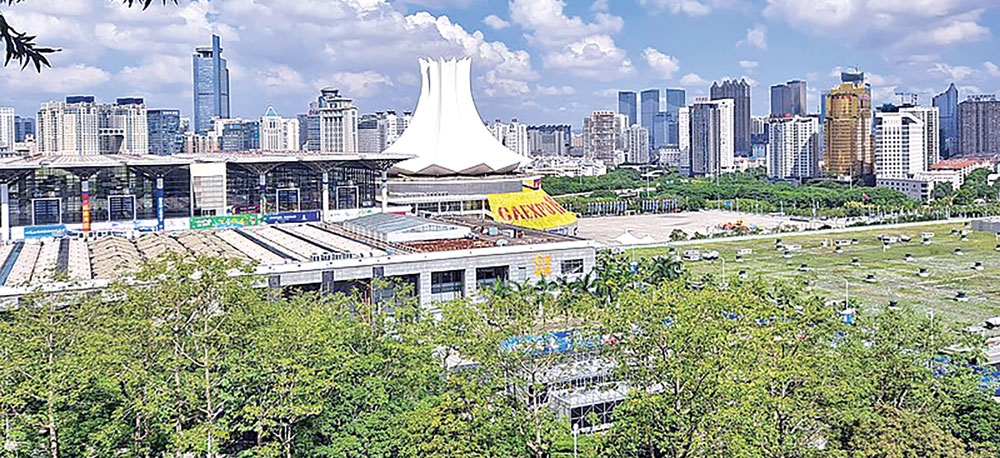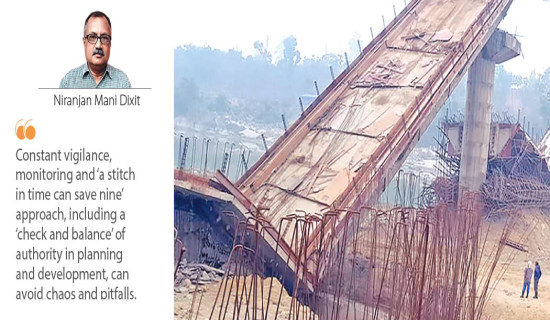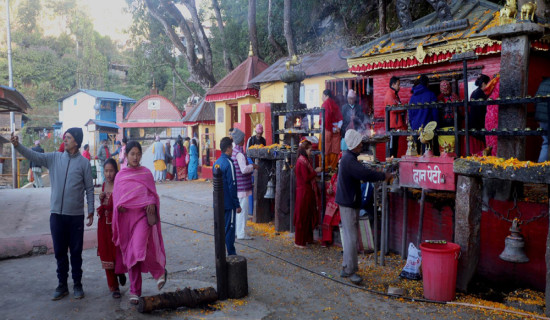- Friday, 21 November 2025
China's Nanning
Where Natural Wonder And Culture Thrive
This imparts lessons for countries like Nepal in the sense that scenic locations can be developed for luring tourists if proper attention is paid to blending both natural and cultural domains.
I had the privilege of joining a multidisciplinary team of professionals, including lawyers, arbitrators, and ADR (alternative dispute resolution) professionals from Nepal associated with the Nepal International ADR Centre (NIAC), to travel to Nanning, the capital city of the Guangxi Autonomous Region of the People’s Republic of China, recently. The NIAC team was invited to participate in the Asia ADR summit, hosted in the Landmark Hotel, Nanning and organised by the Asian Institute of ADR (AIADR) in collaboration with Guanxi University and the Nanning Arbitration Commission. Convened under the rubric “East meets Algorithm: The future of ADR in Asia’s digital wave”.
The summit aimed to explore how technologies, such as artificial Intelligence (AI), blockchain, online dispute resolution (ODR), and smart contracts, are reshaping ADR across Asia and beyond. Nepal International Arbitration Centre (NIAC) was, among others, one of the collaborators of the summit. The travel itinerary was put together by Raintree Nepal, a credible local travel agency possessing expertise in organising such a tour. We took the Sichuan Airlines flight from Kathmandu to fly into Chengdu, the capital city of Sichuan province of China, en route to Nanning. The sky was partly overcast.
Tibetan Plateau
But as soon as the flight crossed into the high Himalayan ranges and vast Tibetan Plateau, I peeped out of the window of the plane and was fascinated and thrilled to see the vast and endless sprawl of the Tibetan Plateau, often called the roof of the world. I recall my school days, especially at the secondary level, when we were taught a physical geography textbook written by Sharan Hari Shrestha in which the Tibetan plateau and the Pamir Knot were described as the roof of the world. Pamirs are the meeting point (or knot) of Asia’s highest mountain ranges. Caravans on the Silk Road and explorers traveling through the Pamir corridor were awed by its majestic look, altitude and harshness, say the old travel accounts.
Flying over the Tibetan Plateau, the desert landscapes unfolded for me like a vast canvas of painting. The terrain beneath appeared broad sweeps of ash-grey sands stretching toward the horizon. The sunlight cast sharp shadows across the barren ground, accentuating dry riverbeds and wind-carved dunes. The desert of the Tibetan Plateau looked as if it were a living body, not lifeless. It looked eternal and majestic. Tibet is said to be the highest and one of the most distinctive landforms on earth.
The Tibetan plateau area is about 2.5 million square kilometres, spanning much of Tibet, parts of Qinghai, and Xinjiang, among others. It contains both mountain and desert features, including cold arid basins. Its vast height creates a third-pole climate, influencing Asia’s monsoons and weather systems. It is surrounded by towering mountain ranges, namely the Himalayas in the south, the Kunlun and Altun mountains in the north, and the Karakorum in the west. The plateau is a source of Asia’s major rivers, including the Indus, Brahmaputra, Yangtze, Mekong, which flow down China, India, Pakistan, Burma, and so on.
State-of-the-art airport
Finally, after three hours in the air, the plane descended into the Sichuan basin, where Chengdu is located. Chengdu has two international airports; we landed at the newly built Chengdu Tianfu International Airport (TFU) – one of the modern and beautiful airports in China. Tianfu Airport has a phoenix-shaped design, symbolising renewal and prosperity. Its flowing rooflines and vast glass walls give it an elegant and graceful look.
Wide walking corridors and clearly marked signs make it easy to navigate, while decorations reflect Sichuan’s cultural heritage. Waiting lounges are decorated with indoor plants and bamboo-inspired designs, bringing nature indoors. Nepali travellers to several destinations in East Asia, including Australia, have started to take the Chengdu route as a transit for their convenience. We met some Nepali passengers at the airport who were travelling to Australia via Chengdu airport.
Chengdu lies in the fertile Sichuan Basin. In a way, it looks like the Kathmandu Valley is surrounded by the natural fortress of mountains. The elegant capital city of Sichuan province serves as the key hub connecting China to Tibet, Myanmar, India, Nepal, and Southeast Asia. Historically, the Sichuan Basin acted as a shield for central China against invasions from the west and southwest. The Sichuan Basin, with Chengdu at its centre, is one of China’s most productive agricultural regions, especially for rice, wheat, and livestock. Chengdu acts as an inland gateway to trade routes linking central Asia and Europe.
Historically, Chengdu was the capital of several Chinese dynasties in the past. Today, it is a leading city in western China’s urbanisation drive, symbolising the shift of economic gravity inland from coastal regions. After almost a three-hour transit wait in the airport, our team took a Sichuan Airlines flight to Nanning, which was around a two-and-a-half-hour cruise on the air. A flight from Chengdu to Nanning in the Guangxi Zhuang Autonomous Region usually heads southeast across China.
We landed at the Nanning airport around midnight. We were impressed by the vastness and beauty of the airport with modern passenger terminals, duty-free shops, and restaurants. It connects major Chinese cities like Beijing, Shanghai, while it offers flights to international destinations in South East Asia, such as Hanoi, Bangkok, Kuala Lumpur, Singapore, and so on. This airport is often called the gateway to ASEAN because of Guangxi’s role in fostering trade, cultural exchange, and connectivity between China and East Asian countries. Jonathan Ha from AIADR was available at the airport to receive our team and led us to the Landmark Hotel, where the second Asian ADR summit was scheduled to be held.
Nanning lies about 300 km from the Vietnam border, connected by road and railway. The summit participants coming from Vietnam shared that they had travelled via road, which took almost six hours for them to reach the location. As Nanning is closer to Vietnam, I developed an interest in knowing how this important city was positioned to help the communists led by Ho Chi-Minh to fight the US together with the US-backed South Vietnamese regime.

Nanning’s location indeed makes it a staging point for commercial supplies heading towards Vietnam and other East Asian nations. During the Vietnam War, according to the reports, Nanning was a very crucial location from a strategic and geopolitical point of view. It was a rear-base logistics hub where China gathered and stored military equipment, food, fuel, and medical supplies before transporting them to Vietnam.
A special Nanning–Hanoi supply corridor was maintained to sustain North Vietnamese war efforts against the US and the US-backed regime in South Vietnam. While China did not send combat troops into South Vietnam, it sent engineering, logistical units to North Vietnam. Many of them were organised and deployed through Nanning. It was also a medical evacuation and treatment hub for wounded Vietnamese soldiers, among others.
The second ADR summit was opened without much ceremonial fanfare, with a key keynote statement delivered by the president of the Asian Institute of ADR (AIADR), Datuk Professor Sundra Raju, a leading international ADR professional. Former Chief Justice of Malaysia Tun gave the keynote speech in which her ladyship focused, among others, on the opportunities and challenges posed by AI in the realm of ADR. In addition to welcome notes, opening statements were delivered by Guanxi University and Nanning International Arbitration Commission representatives, highlighting the innovations and developments in ADR with special reference to China.
The three-day summit featured presentations of ADR experts from different countries, including Malaysia, Vietnam, the Maldives, the Philippines, India, and Nepal. The discussion modalities comprised round table discussions, panel discussions, and Oxford-style debates and town hall sessions, provoking critical and candid sharing on the issues. The presentations dealt with several aspects of ADR, especially with a focus on the rapid changes in the realm of digitisation and the commensurate impact on the realm of ADR.
The discussions focused on how Artificial Intelligence (AI) could be harnessed to aid in buttressing the efficiency and effectiveness of ADR, especially arbitration and mediation. The topics of presentations ranged from the ethics and risks of using AI(large language models), the role of expert witnesses in digital era, dealing with AI-assisted/ generated witnesses, the role of the arbitration tribunal secretary, virtual hearing, institutional or ad hoc arbitration, and so on, which revolved around the evolving opportunities and developments in the field of ADR.
Presentations were also made on behalf of Nepal in the summit where the NIAC signed a memorandum of understanding (MoUs) with four international ADR institutions, including Nanning International Court of Arbitration, China, Asian Institute of Alternative Dispute Resolution (AIADR Malaysia, Philippines International Centre for Conflict Resolution (PICCR), and Kovise Foundation Conflict Resolution International (KFCRI ADR Institution).
Our team, along with the delegates from other countries, had an opportunity to visit the office of the Nanning International Arbitration Commission, where presentations were also made on the state of ADR in the respective countries, including Nepal. The Nanning arbitration commission has specialised institutions within it, which include the financial arbitration institute, construction arbitration centre, commerce and trade arbitration centre, and the tourism complaints and disputes arbitration centre.
Lessons
We had an opportunity to visit the law firms such as Guangxi Guang He Law firm, Guangdong Kingbridge Law firm, and so on. These law firms are known for their special competence and commitment to providing efficient and high-quality legal services. They are well organised and deliver excellent advisory services in addition to litigation representation. They have their branches in some of the other cities in China. During our stay in Nanning, we were taken on a tour to Qingxiu Mountain, which is a scenic natural and cultural attraction. The mountain, recognised for its lush greenery and serene landscapes, is a prominent cultural and historical site.
This picturesque area not only offers beautiful hiking trails but also serves as a peaceful escape from bustling city life. The elevation of Qingxiu Mountain provides an exhilarating view of the surrounding landscape and the city of Nanning. It is interspersed with numerous temples, pavilions, and pagodas that showcase traditional Chinese architecture and culture. This imparts lessons for countries like Nepal in the sense that scenic locations can be developed for luring tourists if proper attention is paid to blending both natural and cultural domains.
(The author is presently associated with Policy Research Institute (PRI) as a senior research fellow. rijalmukti@gmail.com)









